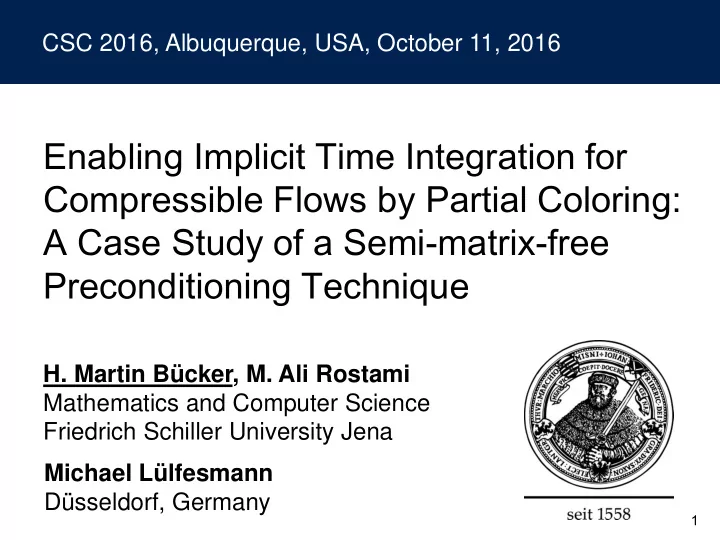

CSC 2016, Albuquerque, USA, October 11, 2016 Enabling Implicit Time Integration for Compressible Flows by Partial Coloring: A Case Study of a Semi-matrix-free Preconditioning Technique H. Martin Bücker, M. Ali Rostami Mathematics and Computer Science Friedrich Schiller University Jena Michael Lülfesmann Düsseldorf, Germany 1
Outline • Problem in Scientific Computing • Combinatorial Model • Heuristic Coloring Algorithm • Experimental Results 2
QUADFLOW Josef Ballmann Mechanics • Finite Volume • Implicit Time Integration • Unstructured Grids • Adaptivity via Multiscale Analysis (Wolfgang Dahmen, Sigfried Müller, Mathematics, RWTH) 3
Large Sparse Linear System = + = 4
Automatic Differentiation (AD) Given , , code to evaluate and seed matrix , generate code to evaluate matrix-matrix product Relative runtime overhead: 5
Preconditioning (PC) Let Rather than Solve 6
Missing Connections: AD and PC Automatic Differentiation: • Access to complete row/column • Access to groups of complete rows/columns Preconditioning: • Access to individual elements • Access to chunks of rows/columns 7
Sparsification 8
Main Idea ( J ) J sparsification preconditioning preconditioning ~ M J ( ) M J 9
Full vs Partial 10
Scientific Computing Problem Problem : Let be a sparse Jacobian matrix with known nonzero pattern and let denote its sparsification using blocks on the diagonal of . Find binary seed matrix with minimal number of columns such that all nonzeros of also appear in . 11
Outline • Problem in Scientific Computing • Combinatorial Model • Heuristic Coloring Algorithm • Experimental Results 12
Full Coloring 13
Full Coloring 14
Partial Coloring 15
Partial Coloring 16
Definition: ρ -Orthogonality structurally -orthogonal to : ≝ There is no row position in which and are nonzeros and at least one of them belongs to . 17
Definition: ρ -Column Intersection Graph associated with a pair of Jacobian matrices and , where represents • ∈ iff and are • not structurally -orthogonal. 18
Combinatorial Problem Problem : Find a coloring of the -column intersection graph with a minimal number of colors. Equivalent to problem . 19
Outline • Problem in Scientific Computing • Combinatorial Model • Heuristic Coloring Algorithm • Experimental Results 20
Greedy Partial Coloring Heuristic 21
Outline • Problem in Scientific Computing • Combinatorial Model • Heuristic Coloring Algorithm • Experimental Results 22
Convergence Behavior with GMRES, ILU(0) 23
Number of Nonzeros 24
Iterations and Colors 25
Zoom into Previous Figure 26
Execution Times 27
Concluding Remarks • Formulation of a combinatorial problem arising from preconditioning using automatic differentiation • Graph model encoding this situation as a partial coloring problem • Design of heuristic partial coloring algorithm • Application to case study from CFD 28
Major References • QUADFLOW: Bramkamp, Lamby, and Müller. An adaptive multiscale finite volume solver for unsteady and steady state ow computations. Journal of Computational Physics , 197(2):460-490, 2004. • Sparsity: Gebremedhin, Manne, and Pothen. What color is your Jacobian? Graph coloring for computing derivatives. SIAM Review , 47(4):629- 705, 2005 • Sparsification: Cullum and Tuma. Matrix-free preconditioning using partial matrix estimation. BIT Numerical Mathematics , 46(4):711-729, 2006. 29
Recommend
More recommend